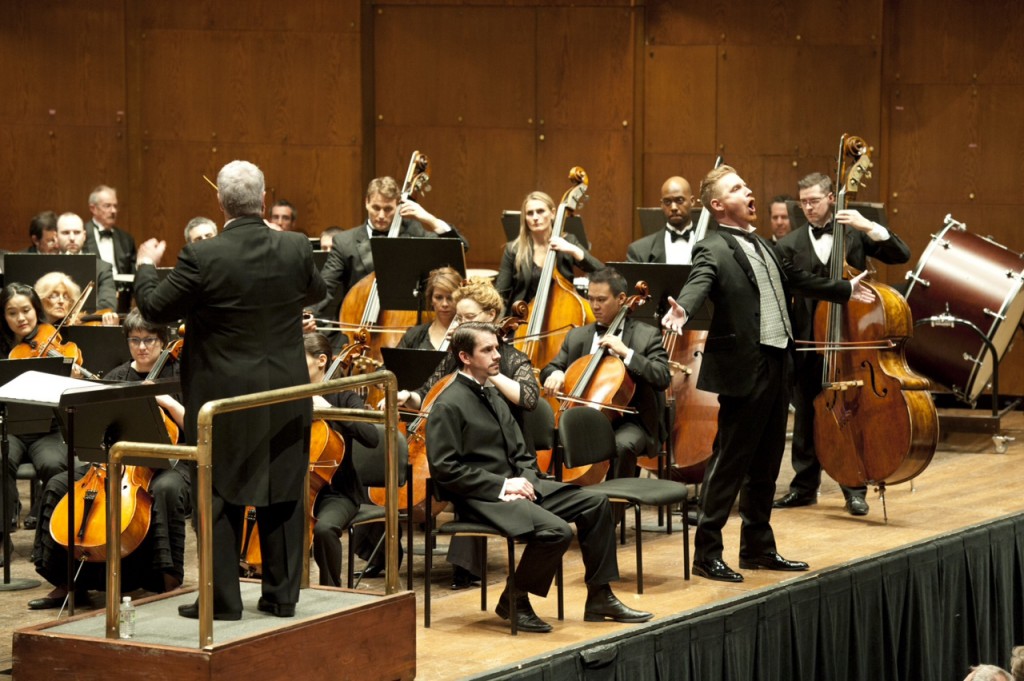Two years ago, I wrote a review for this publication (“MESSIAH…REFRESHED!” November 27, 2011) of a DCINY performance of Handel’s Messiah, which used a re-orchestration of the original score for full symphony orchestra. This massive orchestration (full woodwinds and brass, large percussion battery, and two harps) by Eugene Goossens was written upon a commission from the English conductor Sir Thomas Beecham. In that review I used my two favorite “Beecham stories” which, of course, I can’t use again. Interested readers can refer back to the November 27, 2011 review by clicking here- Messiah Refreshed review 2011.
Hearing Maestro Griffith conduct this work for a second time, I can see how he is trying to balance his innate musicianship, which is of the highest level, with his desire to perform this work as stipulated in Goossens’s score and Beecham’s 1959 recording. It is an interesting problem that has many solutions. By omitting some movements, mostly in Part III, Goossens’s score transformed Handel’s three-part oratorio into a two-part work with a single intermission. He also omitted the “b” section, and therefore the da capo, of two quite long arias, “He was despised,” and “The trumpet shall sound.” Maestro Griffith omitted what Goossens omitted, but he did not take the ponderously slow tempi one hears on the 1959 Beecham recording. But what does one do with ornamentation? There is none in either the Goossens score or the Beecham recording. While this afternoon’s vocal soloists added many ornaments to their vocal lines, none appeared at cadences. For this listener one either follows the non-ornamented Goossens score to the letter or incorporates all we have learned about baroque music since 1959. It seems that Maestro Griffith has pondered this question long and hard, and his feelings are evolving. I admire that and look forward to the results of his ongoing thinking.
Over the years I have thought that the Distinguished Concerts Orchestra was made of freelance musicians brought together just for a specific concert. I have just learned that they are a permanent group, the in-house orchestra of DCINY, and a fine group they are. The fleet-of-foot-tempi chosen by Maestro Griffith might have taxed even a small baroque band, but this massive orchestra performed them with ease and clarity. Except for the booming timpani, the balances were perfect. The wind solos, especially the trumpet in “The trumpet shall sound,” were beautifully played.
The four vocal soloists were all first-rate, making it hard to pick out the high points, but here are a few: Soprano Laura Strickling’s thrilling coloratura in “Rejoice greatly” – the fast tempo allowed her to sing the inhumanly long vocal lines in one breath. Mezzo-soprano Teresa Buchholz’s delivered a most moving rendition of “He was despised” – her voice is beautiful in all parts of her register. I especially loved the plummy low notes. I do wish that Goossens had scored the entire aria. Tenor John McVeigh was a last minute substitution for the scheduled tenor, but one would not have thought so from his assured performance. He sang his opening recitative, “Comport ye,” with beautiful floating tone, and his “Thou shalt break them” had great dramatic fire. Bass Christopher Job was my favorite soloist, although he and Mr. McVeigh tended to rush a bit during their coloratura passages. His voice is thrilling from top to bottom, and his performance of “But who may abide” and “The trumpet shall sound” were, for this listener, the concert’s most memorable moments.
The personnel of The Distinguished Concerts Singers International changes for each performance. This afternoon there were 243 singers on the stage. During the “Hallelujah” and “Worthy is the lamb” they were joined by another 220 singers seated in the first and second tiers of the hall nearest the stage. That makes a total of 463 singers! And a mighty sound it was! Most were members of twelve choruses from the United States, Canada, Australia and China. Also singing were music teachers from the New York City public schools and, as the program stated, “individuals from around the globe.” The chordal sections of the choruses were beautifully sung with a thrilling sound, but many of the polyphonic passages were a different matter, exposing problems of pitch and ensemble.
The excitement in the hall, even before the music began, was palpable. At the end of the “Hallelujah Chorus,” the audience members could hardly contain themselves. Most thrilling, however, was the explosion of applause and bravos which followed hard on the completion of the final “Amen.” And it was justified. The audience of Messiah lovers, friends, neighbors, and family members of the chorus did not have matters of baroque performance practice on their minds. They had just experienced a heartfelt performance of a beloved masterpiece under the direction of a fine conductor. What a fine way to celebrate the beginning of another holiday season!


